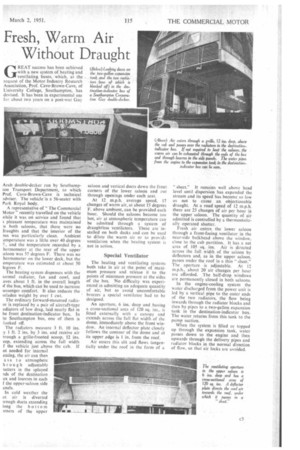Fresh, Warm Air Without Draught
Page 41

If you've noticed an error in this article please click here to report it so we can fix it.
GREAT success has been achieved with a new system of heating and ventilating buses, which, at the , request of the Motor Industry Research Association, Prof. Cave-Brown-Cave, of University College, Southampton, has devised. It has been in experimental use for about two years on a post-war Guy
Arab double-decker run by Southampton Transport Department, to which Prof. Cave-Brown-Cave is technical idviser. The vehicle'is a 56-seater with Park Royal body.
A representative of "The Commercial Motor" recently travelled on the vehicle Nhile it was on service and found that t pleasant temperature was maintained n both saloons, that there were no iraughts and that the interior of the sus was particularly clean_ Ambient emperature was a little over 40 degrees and the temperature recorded by a hermometer at the rear of the upper .aloon was 57 degrees F. There was no hermometer on the lower deck, but the emperature was estimated at about 50 !egrets F.
The heating system dispenses with the tormal radiator, fan and cowl, and ayes about 1 ft. in the overall length if the bus, which can be used to increase iassenger comfort. It also reduces the inladen weight by over 1 cwt.
The ordinary forward-mounted radiaor is replaced by a pair of aircraft-type adiators of low drag, laid nearly flat in he front destination-indicator box. in he Southampton bus, one of them is lanked off.
The radiators measure 3 ft. 10 ins. y 1 ft. 2 ins. by 3 ins, and receive air hrough a grille-fronted scoop, 12 ins. eep, extending across the full width f the vehicle just above the cab. If ot needed for internal eating, the air can then ass to atmosphere hrough adjustable linters in the splayed -ids of the destination ox and louvres in each f the upper-saloon side anels.
In cold weather the ot air is diverted trough ducts extending long the bottom nners of the upper saloon and vertical ducts down the front corners of the lower saloon and out through openings under each seat.
At 12 m.p.h. average speed, 17 changes of warm air, at about 15 degrees F. above ambient, can be provided each hour. Should the saloons become too hot, air at atmospheric temperature can be admitted through a system of draughtless ventilators. These are installed on both decks and, can be used to dilute the warm air or to providt ventilation when the heating system is not in action.
Special Ventilator The heating and ventilating systems both take in air at the point of maximum pressure and release it to the points of minimum pressure at the sides of the bus. 'No difficulty was experienced in admitting an adequate quantity of air, but to avoid uncomfortable breezes a special ventilator had to be designed.
An aperture, 6 ins, deep and having a cross-sectional area of 120 sq. ins., is fitted externally with a canopy and extends across the full flat width of the dome, immediately above the front window. An internal deflector plate closely follows the contour of the dome and at its upper edge is 1 in. from the roof.
Air enters this slit and flows tangentially under the roof in the form of a "sheet." It remains well above head level until dispersion has expanded the stream and its speed has become so low as not to cause an objectionable draught. At a road speed of 12 m.p.h. there are 25 changes of air per hour in the upper saloon. The quantity of air admitted is controlled by a thermostatically operated shutter.
Fresh air enters the lower saloon through a front-facing ventilator in the near-side bulkhead above the window, close to the cab partition. It has a net
area of 105 sq. ins. Air is directed across the full width of the saloon by deflectors and, as in the upper saloon, passes under the roof in a thin "sheet." The aperture is adjustable. Al 12 m.p.h., about 20 air changes per hour are afforded. The half-drop windows are permanently closed in both saloons.
In the engine-cooling system the water discharged from the power unit is led by a vertical pipe to the outer ends of the two radiators, the flow being inwards through the radiator blocks and then by pipes to a two-gallon expansion tank in the destination-indicator box. The water returns from this tank to the pump suction.
When the system is filled or topped up through the expansion tank, water passes down to the engine and then upwards through the delivery pipes and radiator blocks in the normal direction of flow, so that air locks are avoided.




























































































